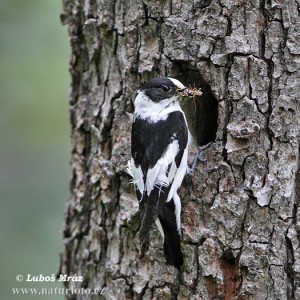
Collared Flycatcher at a tree-cavity.
http://www.naturephoto-cz.com/collared-flycatcher-photo-11697.html
For birds that live in the forest, keeping a nest safe is one of the biggest challenges. Luckily, forests have trees and trees come with an abundance of tree cavities that offer some of the safest nesting sites. However, according to an article published in this month’s issue of the Journal of Ornithology, while there is an abundance of tree cavities in forests, not many bird species use them. Why don’t more bird species use these tree cavities? According to the findings of this study, one of the reasons could be that the tree cavities are simply too dark.
If you can imagine being inside one for a minute, tree cavities are pretty dark places. Additionally, the small amount of light that does enter the cavity might not reach the nest. It makes sense, then, that to have a successful nest in a tree-cavity, the bird species that uses it must both be able to operate in low light conditions and be able to switch quickly between low light and the well-lit world outside of the tree-cavity. While it was previously thought that some bird species might use sensory modalities such as olfaction, touch, and sound to orient themselves in the dark, none of these have been shown in tree-cavity nesters. Therefore, it is pretty “clear” that these species must use their vision to navigate the dark.
Relying on visual cues within the nest cavity comes with some difficulties, and there is limited data on luminance in nest cavities. Researchers here measured illumination in nest cavities of a species of tree-cavity nesters, the Collared Flycatcher Ficedula albicollis in the Bialowieza National Park in Eastern Poland. The researchers measured luminance in 20 Collared Flycatcher pairs’ nest cavities containing 8-12 day-old nestlings. They began their observations before sunrise each day over an 11-day period in June. In addition to recording cavity illumination over the 11-day period, they recorded events such as the time at which parents fed nestlings, weather conditions, and cavity dimensions.
From the luminance values recorded, the researchers can say with confidence that the Collared Flycatcher’s color vision is either highly impaired or lost entirely inside of the tree cavities. The researchers also found that because luminance levels in the nest decline as distance from the entrance increases, birds can control the amount of light reaching the nest by placing it at a certain distance from the entrance. The researchers concluded in their results that only about 4% of the incoming light actually reached the average nest and that birds only built nests deeper in tree cavities if the cavities had larger and more upward-facing openings for more light to enter. There is a clear anti-predator advantage to placing the nest further from the entrance, but the Collared Flycatchers rarely did so. This suggests that deeper nest placement within the cavity is costly and that there is a trade-off between safety and illumination of the nest.
So what? While it might be safer for birds to build nests deep inside of protected tree cavities, these nest cavities pose real sensory challenges for birds…maybe someone should tell them to consider installing some compact fluorescent light bulbs? To learn more, take a look at the original paper in this month’s issue of the Journal of Ornithology.
Reference: Maziarz, M., and Wesolowski, T. 2014. Does darkness limit the use of tree cavities for nesting by birds? Journal of Ornithology 10:1-7.
